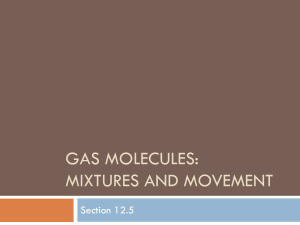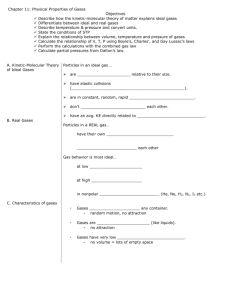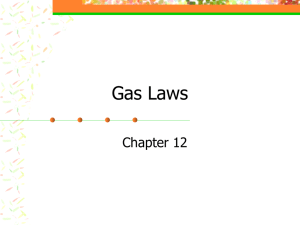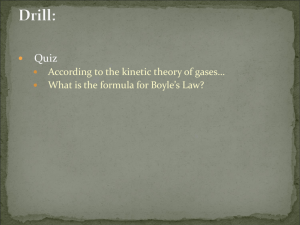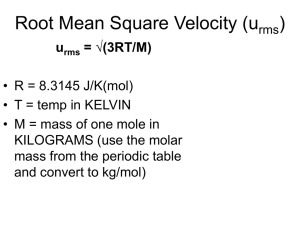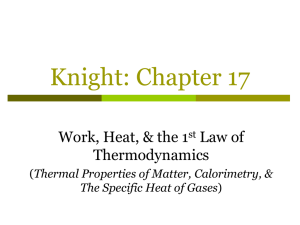Dalton`s Law, Graham`s Law & Real vs. Ideal Gases
advertisement
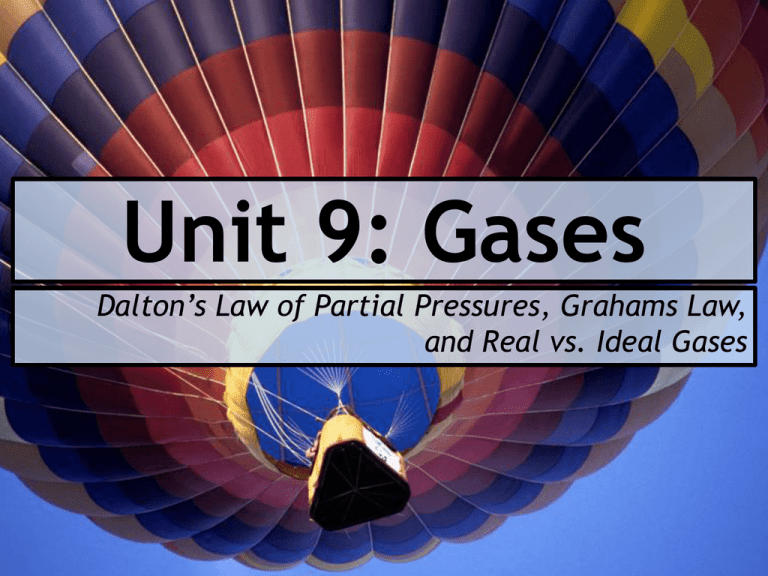
Unit 9: Gases Dalton’s Law of Partial Pressures, Grahams Law, and Real vs. Ideal Gases After today you will be able to… • Describe Dalton’s law of partial pressures and calculate Ptotal or a partial pressure • Explain Graham’s law of effusion and calculate the rate at which gases effuse • Explain what is meant by the term “real” vs. “ideal” gases Recall, gas pressure results from collisions of gas particles. •Gas pressure depends on the amount of gas and the KE of its particles. •Since particles in a mixture of gases at the same temperature contain the same average KE, the kind of particle is unimportant. Example: Composition of Dry Air Component Volume Partial Pressure Nitrogen 78.08% 79.11 kPa Oxygen 20.95% 21.22 kPa Carbon dioxide 0.04% 0.04 kPa MISC gases 0.93% 0.95 kPa Total 100.00% 101.32 kPa “The total pressure of a mixture of gases is equal to the sum of the individual (partial) pressures.” Dalton’s Law of Partial Pressures Ptotal= P1 + P2 + P3… Units of pressure must match! Example: Dalton’s Law What is the total pressure for a mixture of O2 and CO2 if PO2= 0.719 atm and PCO2= 423mmHg. 760mmHg PO2= 0.719atm x = 546mmHg 1atm PCO2= 423mmHg Ptotal=546mmHg + 423mmHg Ptotal=969mmHg Thomas Graham (1846) •Diffusion: Is the tendency of gas particles to spontaneously spread out until uniformly distributed. •Effusion: The escape of a gas through a tiny pinhole in a container of gas. –Gases with lower molar masses effuse more quickly. “The rate of effusion of a gas is inversely proportional to the square root of the gas’s molar mass.” Graham’s Law of Effusion Rate A = √MMB Rate B √MMA Always place the larger molar mass in the numerator! Example: Graham’s Law Which gas effuses faster, H2 or Cl2? How much faster? Rate H2 √MMCl2 = Rate Cl2 √MMH2 Rate H2 √(70.90) = Rate Cl2 √(2.02) = 5.92x H2 effuses 5.92x faster than Cl2 Real vs. Ideal Gases •The gas laws we’ve learned in this unit are based on a gas that behaves “ideally.” •An ideal gas has: –No molecular volume –No attractive forces •In reality, there are no perfectly ideal gases. But, under most conditions, real gases will approximate ideal gas behavior. •However, under certain conditions, real gases will deviate from ideal gas behavior. Real vs. Ideal Gases •These deviations occur for: 1. High pressure: Gas particles are pushed closer together, more attractive forces result. 2. Low Temperature: The gas is compressed, there are more attractive forces. 3. High molar mass: Higher molar mass of the molecule usually means larger volume. 4. Polar molecules: Unequal sharing of electrons creates an attraction between molecules.



